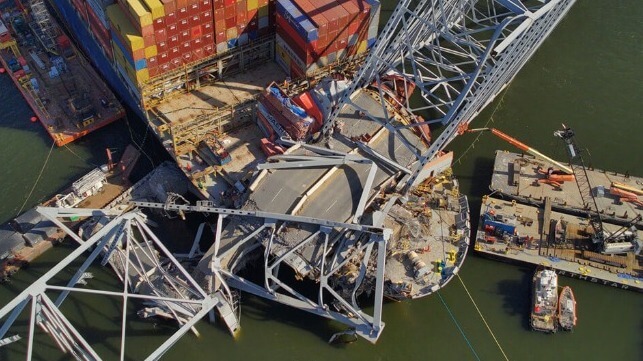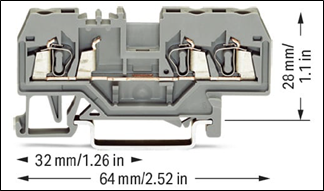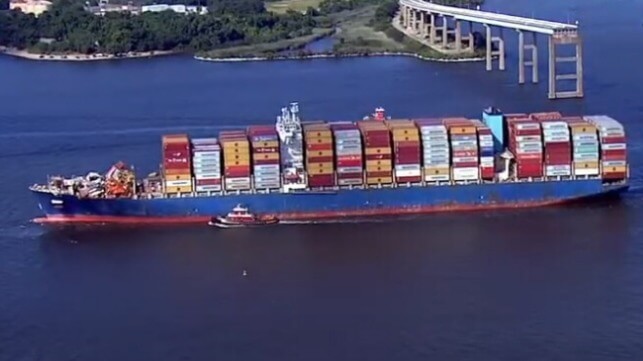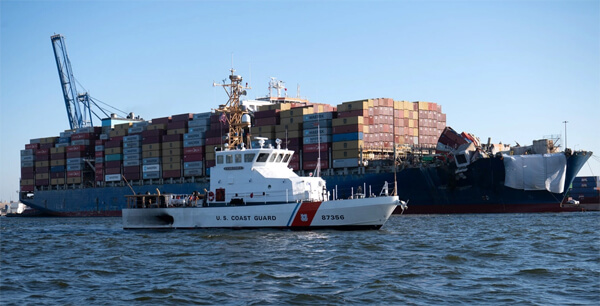NTSB Homes In on Connector Device From Dali's Switchboard

The NTSB has issued an update on its investigation into the disastrous allision of the boxship Dali with the Francis Scott Key Bridge in March, which destroyed the span, killed six workers and blocked off Baltimore's federal shipping channel for months.
The container ship lost electrical power twice as it approached the bridge on the accident voyage. Both times, mission-critical circuit breakers that connect the ship's generators to the rest of the electrical distribution system tripped (opened), turning off all the lights - even though the generators continued to run.
The loss of electrical power temporarily disabled the ship's rudder and forced a shutdown of the main engine, causing the Dali lose propulsion and heading control as she approached the bridge's main spain. Though backup control of steering was restored when the emergency generator started, it was too little and too late to prevent an allision with the southwestern bridge pier. Dali's momentum crushed the pier on impact, collapsing the entire bridge truss in seconds. The damage will likely take years to restore.
According to NTSB, the first set of breakers (HR1 and LR1) tripped when the Dali was just three ship lengths away from the bridge, causing the first blackout. With help from the OEM, the crew and other experts, NTSB has been examining these breakers closely at the component level to determine what might have gone wrong.
During testing, the investigators noticed "an interruption in the control circuit for HR1's undervoltage release." The undervoltage release is a device that trips the breaker when the voltage falls below a set threshold.
 The team pulled a terminal block - a female connector socket for plug-in components - out of the control circuit for the breaker undervoltage release (illustration at left, courtesy WAGO). Two sections of the control wiring associated with this terminal block were also removed from the switchboard, and these components were taken back to NTSB's laboratory for further testing.
The team pulled a terminal block - a female connector socket for plug-in components - out of the control circuit for the breaker undervoltage release (illustration at left, courtesy WAGO). Two sections of the control wiring associated with this terminal block were also removed from the switchboard, and these components were taken back to NTSB's laboratory for further testing.
The agency did not release further information on its findings, and it emphasized that the update should not be taken as a conclusion about the root cause of the casualty. The broader investigation into the allision is still under way; while NTSB has no formal timeline for completion, based on the length of past inquiries, the process often takes approximately one year.
Video: Containership Dali Underway Three Months After Baltimore Allision

After a slight delay over the weekend, the containership Dali which became infamous for her allision with the Francis Scott Key Bridge in Baltimore got underway on Monday morning bound for Norfolk, Virginia. It is a carefully choreographed exercise as the vessel remains heavily damaged including without anchors and with debris and containers still aboard.
The U.S. Coast Guard reports she is traveling under her own power with a full crew of 22 aboard as well as six salvage experts from Resolve Marine. Four tugs are accompanying the vessel on the trip which is expected to take 16 to 20 hours. The Coast Guard cutter Sailfish from Norfolk is maintaining a 500-yard safety zone around the ship and the salvage vessel Inceptor from Resolve Marine is following the trip. AIS signals show her traveling at 8 to 10 knots.
Strong safety protocols are being enforced during the transit as well as monitoring by the Coast Guard. One concern is that some of the debris might come loose and fall overboard, although most of the damage at the bow was secured or removed and a tarp was placed over some of the damaged areas. As an added precaution, the Maryland Transport Authority reported that traffic would be stopped on the Bay Bridge crossing the Chesapeake near Annapolis while the vessel transits the area.
MDTA footage of the Dali clearing the Bay Bridge this morning
The delays included last-minute arrangements for two additional crewmembers, both cadets, to leave the vessel. Initially, an agreement was made for eight ratings to return home to India and Sri Lanka as long as they would be made available or later depositions. The cadets were added to the agreement. The Dali had been at the Seagirt Terminal in Baltimore for the past 35 days for salvage operations after being removed from the bridge debris.
According to media reports, four of the original crewmembers are staying with the vessel during the trip to Norfolk. Synergy Marine arranged for a replacement crew to join the vessel last week. Seven crewmembers were being transferred to hotels or apartments in the Baltimore area to await depositions and the legal cases. The four others presumably will be returning to Baltimore as they are also parties to the various legal cases and potential actions by the U.S. Department of Justice.

Dali preparing to depart with USCG escort and tarp covering damaged areas (USCG photo)
Once the Dali reaches Virginia, she will be first going to the Virginia International Gateway in Portsmouth on the Elizabeth River south of Norfolk. Virginia International Gateway is a privately owned terminal leased by the Virginia Port Authority. It is one of the VPA’s two main container terminals. There the Coast Guard reports at least 1,500 containers will be offloaded from the Dali to reduce the vessel’s draft.
At a later date, the Dali will again be shifted this time to the Norfolk International Terminal. While in Norfolk the vessel is to receive initial repairs before the owners, Grace Ocean, transfer her to another shipyard likely in Asia for additional repairs.
No comments:
Post a Comment